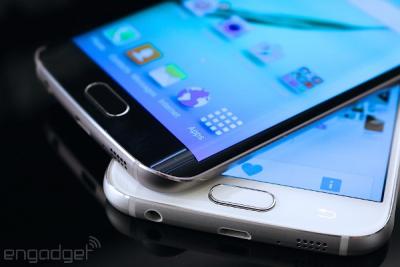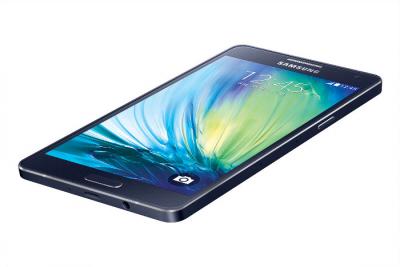OLED displays use organic materials that emit light when electricity is applied. OLEDs enable emissive, bright, thin, flexible and efficient displays. OLEDs are replacing LCD displays in mobile devices and TVs.

Samsung's Super-AMOLED displays, announced in January 2010, are AMOLED displays with an integrated touch function. In a Super AMOLED display, a touch-sensor is placed over the display (on-cell). The thickness of the touch sensor is just 0.001 mm and this allows the screen to provide better images and to have great visibility even in direct sunlight (Samsung says that they perform 20% better than regular touch AMOLED outdoors).
In 2010 or so, achieving an HD resolution in a mobile phone was a great achievement, and Samsung used to market those displays as Super AMOLED HD or HD Super AMOLED display to make sure people know these are HD displays. Today, as most high-end mobile displays sport Full-HD (or even higher) resolutions, Samsung no longer adds the HD before or after the Super AMOLED.

Further reading
The latest Super AMOLED HD news:
Samsung announces a Korean Galaxy S II variant with a Super AMOLED HD display
Samsung announced two new Galaxy SII variants - both with LTE, and both for the Korean market. The more interesting one is the Galaxy S II HD LTE which offers a 4.65" Super AMOLED HD display - offering 1280x720 resolution (316ppi, most likely with Pentile). The second phone is the Galaxy S II LTE which has a 4.5" 480 x 800 display (207ppi).

Beside the display, both phone feature LTE of course, a 1.5Ghz dual-core processor, 8mp camera (1080p video), 16GB of internal memory, Wi-Fi, GPS and NFC.
Rumors surface on a Galaxy SIII with a Super AMOLED HD and an OLED iPhone
Samsung's Galaxy S II is just starting to appear in the US, and it's already time to start speculating on its successor - the S III. According to an anonymous user in a message board, the S III will have 2 Ghz quad-core processor, the latest Ice Cream Sandwich OS, a 10mp camera, NFC and 1080p 60 fps video. But we're mostly interested in the display - a 4.65" Super AMOLED HD display offering a strange 1280x1024 resolution (352 ppi?).
These specs seems very optimistic, especially the display. The first Super AMOLED HD device, the Galaxy Note phone has a 1280x800 resolution on a 5.3" display (using PenTile technology). This means that Samsung will need to improve the ppi quite a bit. And the 1280x1024 resolution doesn't really make sense, does it?
Samsung's Galaxy Tab 7.7 Tablet and Note smartphone hands on
Following yesterday's exciting launch of the 5.3" HD Super AMOLED Galaxy Note phone and the Galaxy Tab 7.7 Super AMOLED tablet, here are a couple of hands on videos showing these two devices:
Samsung launches the 7.7" Super AMOLED tablet and the 5.3" HD Super AMOLED phone
Samsung launched three OLED products today, two of which are very exciting. The first is the Galaxy Tab 7.7, which has the world's largest mass-production OLED display at 7.7" (1280x800). It's a Super AMOLED Plus display. Other include Android v3.2, Dual-core 1.4Ghz processor, HSPA+ radio, 16GB to 64GB internal storage and a microSD slot, Wi-Fi, GPS and two cameras (3MP and 2MP).

The second exciting product is the Galaxy Note, a 5.3" Super AMOLED phone, offering the same resolution as the Tab - 1280x800. Samsung is using PenTile here. They are not using the Super AMOLED HD brand we thought they'd use, istead they simply call it a HD Super AMOLED display. It seems that Samsung will use Super AMOLED for PenTile displays and Super AMOLED Plus for non-pentile display, regardless of pixel density.
Super AMOLED HD is real, Samsung developed an improved process and uses new materials
I just had an interesting talk with two industry insiders (one of them is a Samsung supplier) - about Samsung's upcoming Super AMOLED HD display. It turns out that these displays are indeed real - and will be unveiled soon. We can expect 5" to 6" smartphones in fall 2011 (the first will probably be the GT-I9220 with a 5.3" display) and 7" tablets by the end of 2011.
 A 7-inch Super AMOLED prototype
A 7-inch Super AMOLED prototype
According to my sources, Samsung managed to achieve HD resolution on these small displays by using PenTile matrix again (like in the original Super AMOLED displays). They have also developed a new manufacturing process and are using new materials. It might be that they have finally started to use Universal Display's green PHOLED (we reported that Samsung is using a green phosphorescent in their new 5.5-Gen plant, but perhaps they will only start using it in the HD displays).
Samsung phone roadmap leaked, a 5.3" Super-AMOLED Plus phone coming?
 Samsung's phone roadmap was leaked - showing us 9 upcoming phones and two tablets. There are two AMOLED phones in there. The first is the GT-I9220-W43 which features a 5.3" 1280x720 Super-AMOLED-Plus display (or Super-AMOLED-HD?). This might be the Galaxy-Q phone we heard about a few weeks ago. Achieving 720p resolution on a 5.3" display requires around 270 ppi - which isn't possible with Samsung's current AMOLED technology, so we'll label this rumor 'unlikely'?
Samsung's phone roadmap was leaked - showing us 9 upcoming phones and two tablets. There are two AMOLED phones in there. The first is the GT-I9220-W43 which features a 5.3" 1280x720 Super-AMOLED-Plus display (or Super-AMOLED-HD?). This might be the Galaxy-Q phone we heard about a few weeks ago. Achieving 720p resolution on a 5.3" display requires around 270 ppi - which isn't possible with Samsung's current AMOLED technology, so we'll label this rumor 'unlikely'?
The second AMOLED phone is a Bada hone - the Wave III (S8600-W47). It will have a 4" Super AMOLED display.
Super AMOLED HD to use PenTile technology?
There are rumors that Samsung is set to release a new Galaxy S II variant (code named Celox) with LTE. The interesting bit is that it is said that this phone will sport Samsung's new Super AMOLED HD display rather than the Super AMOLED Plus used in regular S II phones - and that Super AMOLED HD will use PenTile matrix again.
 Galaxy S II
Galaxy S II
So if Samsung goes back to PenTile, this might explain the resolution increase, although it will still be unrealistic to expect an HD (1280x800) resolution on a 4" display - even with PenTile, as Samsung will not be able to move beyond 200ppi using their current FMM technology. In any case, it seems rather unlikely for Samsung to go back to this technology after telling us that normal matrix is better in Super AMOLED Plus displays...
Samsung to introduce 7" Super AMOLED displays soon? Will that be the Super AMOLED HD?
There are reports that Samsung plans to introduce new 7" AMOLED displays later this year. According to these reports Samsung's new AMOLED displays will feature 1024x768 - and be used by Samsung Electronics in new Tablets, released towards the end of 2011.
 A 7-inch Super AMOLED prototype
A 7-inch Super AMOLED prototype
But in the same article they say that Samsung aims to introduce Full-HD tablets as well. Perhaps the new 7" panels will offer 720P HD resolution (1280Ã720)? This makes sense as the pixel density for such a display is about 180ppi - which is achievable in Super AMOLED Plus displays. In fact this may be the Super AMOLED HD display we keep hearing about lately...
Is Samsung working on a 5.3" Super AMOLED Plus phone?
There are reports that Samsung is working on a new device called the Galaxy Q that will bridge the gap between the smartphone and the small tablet. It will have a Super AMOLED Plus 5.3" display. The Q will come in two versions: 3G and LTE, and will launch in September during the IFA 2011 exhibition in Germany.
 A 7-inch Super AMOLED prototype
A 7-inch Super AMOLED prototype
Achieving an HD (720p) display on a 5.3" screen requires around 270 ppi - which means that Samsung will not be able to offer that resolution using their current technology (which limits AMOLEDs to around 200 ppi). So this is probably not the rumored Super AMOLED HD display.
More rumors on the upcoming Super AMOLED HD displays
Update: Engadget says that Samsung will not confirm the rumor - saying that the information on these tweets came from an external source...
A few weeks we reported that there are rumors regarding a new Super AMOLED HD display coming from Samsung - featuring 720p (1280x720) resolution. It was rumored that this display will first appear in Google's upcoming Nexus 3 phone, and today we hear that Samsung Mobile Romania twitted about the upcoming Nexus S - and confirmed the Super AMOLED HD display.

Having such a display on a mobile phone seems highly unlikely. Samsung currently can't make such a high PPI AMOLED (unless they move to LITI, but this isn't expected anytime soon). Perhaps the Nexus 3 will actually be a tablet and not a phone? Or perhaps Samsung will surprise us all with a remarkable new AMOLED technology...
Pagination
- Previous page
- Page 6
- Next page



